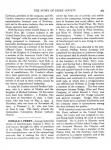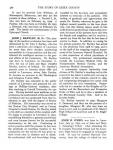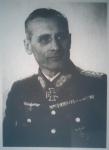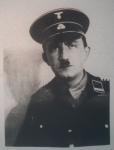-
Posts
4,908 -
Joined
-
Last visited
-
Days Won
97
Content Type
Profiles
Forums
Blogs
Gallery
Events
Store
Everything posted by Dave Danner
-
Hi all, I wonder if anyone can add any missing details to this rather interesting military career: am Ende, Ludwig Ernst Johannes (Hans) Kunstmaler, Mitbegründer der Künstlerkolonie Worpswede. 31.12.1864 geb. in Trier 15.12.1892 Second-Lieutenant d. Res. (I München) im 13. Inf.-Regt. 12.06.1901 Oberleutnant d. Landw. (Aschaffenburg) 27.12.1903 Abschied bewilligt ??.??.1914 freiwillig im preußischen Heer eingetreten ??.??.19?? Hptm.d.L.a.D. im IR 162 10.04.1918 schwer verwundet bei Messines 09.07.1918 gest. infolge Verwundung in Stettin • 1914 Eisernes Kreuz 1. u. 2. Klasse • Ritterkreuz mit Schwertern des Kgl. Hausordens von Hohenzollern • Lübecksches Hanseatenkreuz • Fürstl. Schwarzburg-Rudolstädtsches Ehrenkreuz 3. Klasse mit Schwertern • Fürstl. Schaumburg-Lippischer Orden für Kunst u. Wissenschaft 1. Klasse • Kgl. Bayerische Landwehr-Dienstauszeichnung 2. Klasse Hans am Ende was born in Trier and, according to his Wikipedia bio, his family moved to a village near Naumburg a./Saale in 1872. Though a Prussian citizen, he presumably ended up in the Bavarian Army because he did his initial military service while a student at the Akademie der Bildenden Künste in Munich. He co-founded the artists' colony in Worpswede in 1889. Worpswede is only about 17.5 km from the center of Bremen, and am Ende exhibited works there, so I suppose it is also possible that Bremen awarded him its Hanseatenkreuz. Also, Bremen to Bavaria also seems like an awfully long commute for a reserve/Landwehr officer! The Schaumburg-Lippe award is the only arts and sciences award in his DOA entry, but I suppose it is possible he received others after 1909. He does not have any Schwarzburg-Rudolstadt connection that I know of, but his SEK3X was awarded on the same day as two other officers from IR 162, so I suppose the regiment submitted these officers along with a list of enlisted Schwarzburg citizens under their command.
-

Uncategorised Allies (Mixed)
Dave Danner replied to Chris Boonzaier's topic in World War II 1939 to 1945
Jedburgh team? -

EK 1914 Württemberg Armee Korps Documents
Dave Danner replied to Chris Boonzaier's topic in Germany: All Eras: The Iron Cross
Lt.d.R. Karl Krauß from GR 123 was fairly well-decorated. Besides the EK1 & EK2, he received the Oldenburg Friedrich August Cross 1st and 2nd Class, the Württemberg Golden Military Merit Medal, and the Württemberg Military Merit Order in place of his Golden Military Merit Medal. There was a Lt.d.R. Karl Krauß, born on 26 October 1892 in Heilbronn, who was lightly wounded in November 1915 with 3./RIR 122 and severely wounded and taken prisoner in late 1918 with 3.MGK/IR 413, both Württemberg regiments. The only other Karl Krauß I can find in the Württemberg Army was a pioneer officer (PB 13 and GdResPionR), so this Heilbronn-born infantry officer is probably your man. -

EK 1914 Württemberg Armee Korps Documents
Dave Danner replied to Chris Boonzaier's topic in Germany: All Eras: The Iron Cross
It would appear that Friedrich Forschner never saw his award. He was reported as missing in action in October 1914, probably on the date given on this award. In July 1916, the French reported that he had been killed. -

EK 1914 Württemberg Armee Korps Documents
Dave Danner replied to Chris Boonzaier's topic in Germany: All Eras: The Iron Cross
From what I can tell, the 1. Garde-Reserve-Division was in the reserve of the 6.Armee from 5 October 1915 to 8 May 1916, and then went into the line in Flanders. XIII.Armeekorps had been transferred to Flanders in December 1915, so the division must have been attached to the corps in June when the award was made. Uffz. Martin Günster was wounded later in 1916, apparently in the Battle of the Somme. He was born on 30 December 1888 in Laudert, Landkreis St. Goar. -
So far, the most senior Polish-German officers I have come across are: • Kasimir v. Grudzielski (9.5.1856-31.3.1921), in 1914 an Oberstleutnant z.D. and Kdr. Landwehrbezirk Montjoie, retired in 1917. At the time of his death, he was a generał dywizji in the Polish Army. • Kasimir v. Raszewski (29.2.1864-14.1.1941), in 1914 a Major on the staff of HR 16, then commander of the regiment from 1914-18. Promoted to Oberstleutnant on 22.3.18, and entered the Polish Army as a colonel (pułkownik). Retired in 1925 as a generał broni. A Polish monarchist, he apparently remained close to some of his old German comrades after retirement, which did not stop the Gestapo from arresting him in 1939. He died shortly after his release from imprisonment. Other than these two, there do not appear to have been many former German officers among the senior leaders of the Polish Army. I suspect this is mainly because there weren't as many Polish officers in the Prussian Army as there were in the Austro-Hungarian and Russian Armies. But there also may have been cultural and political biases in the Second Republic between Poles from formerly Prussian lands and Poles from Austria-Hungary and Russia. Regards, Dave
-
This is the standard form for a Kriegsrangliste/Kriegsstammrolle. • Column 1 is the number for the Kriegsrangliste entry. • Column 2 is his rank • Column 3 is his name • Column 4 is his religion • Column 5 is date and place of birth • Column 6 is his occupation and place of residence • Column 7 is for marital status, here "L" for ledig, unmarried • Column 8 is for his parents • Column 9 is his parent unit • The unnumbered section below these is for notes. Here one usually finds a list of wounds, hospital stays, periods of leave. Here there is a notation for a 3-week leave in December 1916 and a notation that he was released to the Ersatz-Eskadron of the regiment for release from active duty because the Handelskammer in Bremen requested his return. • Column 10 has two sections. The top shows date of entry into the military, and the lower one shows date of rank • Column 11 is for combat participation. Here, since he was with the same regiment for all his war service, they simply attached a copy of the regiment's combat participation, with a few notes • Column 12 is for decorations • Column 13 is a record of military service, before the war and after mobilization Regards
-

Imperial Russia Mickey Rourke wearing St. George Cross in Iron Man 2?
Dave Danner replied to paja's topic in Russia: Imperial
Yes, that's the White Falcon. The decoration below the Red Eagle and the matching cross below the EK1 are for the Bulgarian Military Merit Order. I imagine the White Falcon was used because Forman did not have a breast star for the House Order of Hohenzollern, which would make more sense. I don't think the Kaiser would wear a Saxe-Weimar award unless he was meeting with the Grand Duke or visiting a Saxe-Weimar unit, since wearing only one state's award might be seen as an insult to the other states of the Empire (I'm not counting the medal bar since that was meant to represent every state and ally that gave him a war award). -
The Austrian Military Merit Cross was for officers, so your guy was likely a junior officer - Lt.d.R., Lt.z.S. or the like. Maybe not a native of Hamburg, since he placed the Hamburg decoration lower on the later bars. Possibly a reserve officer in WW2. An E-Offizier with WW1 and post-war service in Schlesien would likely have at least a Wehrmacht 4-year DA. The HH after the FKE is incorrect, but since these are the ones with tabs that come off individually, someone probably just mismounted them.
-
Assuming the 1. Chevaulegers connection is correct, it looks like the likeliest candidate is: Dr. jur. Karl Gluud, born 12.10.1883 in Bremen. After legal studies at Heidelberg, Munich and Jena, he received his Dr. jur. from the University of Jena on 25.11.1910. He was a Syndikus in the Handelskammer in Bremen when the war started. While a student in Munich, he served as an Einj.-Frw. in the 1.ChevR from 1.10.06-30.9.07. On mobilization, he joined the regiment as an Offz.-Stellv. in the 1.Eskadron. He was promoted to Lt.d.L.-Kav. 1.Aufgebot on 27.11.14 and OLt.d.L.-Kav. on 15.3.18. He received his EK2 on 13.8.15. No dates are given for his BMV4X and Bremen Hanseatenkreuz. I saw two other officers in 1.ChevR with Bremen citizenship, but one also had the Prinz-Regent-Luitpold-Medaille and the other only had a Military Merit Cross 3rd Class with Crown and Swords, not the order. It is possible that this second officer, Lt.d.R. Andreas Helms, might have gotten a post-war Military Merit Order 4th Class (they were awarding them to 1920 at least) which is not in his Kriegsrangliste entry, and wore that in place of his earlier Military Merit Cross. So the chain might still be his, but he would have been entitled to wear both the cross and the order, so maybe not. And there might be another Chevauleger with the Bremen Hanseatenkreuz whom I missed. But Dr. Gluud seems like a good possibility. Regards, Dave
-
Here is his entry in The Amherst Memorial Volume; a Record of the Contribution Made by Amherst College and Amherst Men in the World War, 1914-1918: Here is a bit more biography from The Story of Essex County, published in 1935.
-
There are any number of scenarios. One of the most common would be a native of Bremen who went to college in Bavaria, perhaps in Erlangen or Munich, and so he did his one-year volunteer service in a Bavarian regiment. He ends up with a Bavarian commission and gets the Bavarian order as a Bavarian Lt.d.R. and the Bremen cross as a native of the city-state. Or he could simply be a native Bremener who lived and worked in Bavaria. Or even a navy officer serving on the SMS Bayern or some other ship with a tradition connection to Bavaria. Or a Prussian officer, native of Bremen, but who trained as a pilot through Bavarian Armee-Flugpark 6 and spent time in a Bavarian squadron. I would say the lack of a Prinz-Regent Luitpold Medal on the ribbon of the Bavarian Army Jubilee Medal does mean that if he was a Bavarian officer, it was after 1911. Regards, Dave
-
For what it's worth, the guy in my photo paid a heavy price for his devotion to the cause. As commander of the Panzer-Artillerie-Regiment of the Panzer Lehr Division, he was wounded and captured by Canadian troops on 8 June 1944, and according to various reports mistreated by the Canadians, and finally died on 18 June.
-

Japan Preußisch Oberleutnant with 4th class Sacred Treasure
Dave Danner replied to JapanX's topic in Japan
I don't know when the Japanese Emperor awarded the order, but the Prussian King approved it in the Ordensfest 1900 in January of that year. A large number of Japanese awards were approved on this date. I cleaned it up a little for easier reading. -
No luck at the archives. There was no HPA file, no casualty card, no SS file, and no SA file. He probably retired before 1945, so his file was no longer with the active officer files. He is also not in that "Offiziersliste 03.01.39" being published on the Panzer-Archiv.de forum. There are names missing from that list, however. I don't have any original 1939 seniority lists or Stellenbesetzungen to check. If he entered service in September 1909 and had his 25 years' service by September 1939 (how late did they award Wehrmacht DAs?), then he could only have been out of qualifying service for no more than 5 years. Since he is not in Reichswehr rank lists, that leaves a few possibilities: (1) He was an E-Offizier in the Kriegsmarine, whose DA is identical. Not likely, but I don't have any Navy references to check. (2) Polizei (3) Angestellter im Reichswehrdienst If he is not in the 3.1.39 Offiziersliste but he was active before the end of 1939 to get the WHDA1, then he could have been a Reichswehr/Wehrmacht civilian official (and perhaps reserve officer) and went on active duty in 1939. Most Army officers who went from the Imperial Army to the police to the Wehrmacht were transferred from the police on 15.10.35, but I suppose he could also have stayed in the police until 1939. Long story, short: I got nothin' to add.






